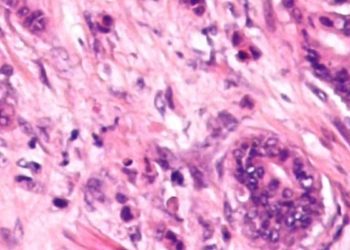Twin vaginal delivery as safe as cesarean [Classics Series]
1. Among women with cephalic-presenting diamniotic twins at term, those randomized to planned cesarean delivery were not more likely to experience adverse neonatal outcomes compared to those randomized to planned vaginal delivery.
2. Compared to planned vaginal delivery, scheduled elective cesarean delivery conferred no more than a 23% reduction and no more than a 74% increase in the odds of neonatal death or serious morbidity.
3. There was no difference in the incidence of the composite outcome for maternal morbidity and mortality between women assigned to planned Cesarean compared and those randomized to planned vaginal delivery.
Original date of publication: October 2013
Study Rundown: Twin birth is associated with a higher risk of adverse perinatal outcomes but it is unclear whether method of delivery meaningfully alters these risks. Over the years, a widespread assumption developed that Cesarean delivery is safer. This is both because some women are unwilling to accept the risks associated with vaginal delivery (e.g. head entrapment in the instance of breech presentation requiring extraction for twin B) and because several cohort studies demonstrated reduced risk of adverse events for the second twin or both twins when delivered via Cesarean section (see relevant reading). This assumption has been translated to practice such that all women pregnant with twins are offered an elective primary Cesarean delivery. Recently, however, small trials demonstrated that perinatal outcomes were no better following planned Cesarean versus vaginal delivery. Because of these results and the understanding that cohort studies are subject to bias and confounding, researchers questioned whether Cesarean delivery truly lowered risk for adverse events. Given the increasing frequency of twin pregnancies and the public health goal to decrease Cesarean delivery and Cesarean-associated morbidity and mortality in the United States, researchers designed a large randomized controlled trial to assess whether perinatal outcomes differed by planned mode of delivery. Results demonstrated that perinatal outcomes were no better nor worse following scheduled cesarean delivery compared to scheduled vaginal delivery.
This landmark study demonstrated that for women with diamniotic twin gestations with cephalic-presenting first twin between 32 and 39 weeks gestation, scheduled elective Cesarean delivery did not confer a decreased risk of adverse neonatal outcomes compared to planned vaginal delivery. Strengths include multi-center randomized controlled trial with central randomization and large sample size of 2804 women. Results may not be applicable to delivery centers without the capacity to perform emergency cesarean section within 30 minutes when necessary. Future studies might restrict to dichorionic, diamniotic gestations and include long-term follow-up data.
Click to read the study in NEJM
Relevant reading: Birth order, gestational age, and risk of delivery related perinatal death in twins: retrospective cohort study
In-Depth [randomized controlled trial]: A total of 2804 women from 32 weeks until 39 weeks gestation were centrally randomized to planned cesarean section (n=1398 women; n=2795 fetuses) or planned vaginal delivery (n=1406 women; n=2812 fetuses) in this multi-center randomized trial. Monoamniotic gestations were excluded. Elective delivery by either cesarean section or planned induction of labor was performed between 37 weeks 5 days and 38 weeks 6 days gestation. In vaginal deliveries, if the second twin was not cephalic-presenting, the obstetrician determined the ideal mode of delivery for the second twin (breech extraction, version, intrapartum cesarean section). Primary outcome was a composite of neonatal mortality and morbidity (e.g. birth trauma, Apgar <4 at 5 minutes, septicemia, Grade III or IV intraventricular hemorrhage, coma, need for intubation and other markers of serious neonatal morbidity) and mortality. Secondary outcome was a composite of maternal morbidity and mortality, including death, postpartum hemorrhage, laparotomy, thromboembolism, among others. Outcomes were assessed via intention-to-treat analysis. Of women randomized to planned vaginal delivery, >40% of women ultimately underwent Cesarean delivery of one or both fetuses due to maternal or fetal indications, failed induction of labor or failure to progress.
Compared to women randomized to planned vaginal delivery, those randomized to planned cesarean delivery were neither more nor less likely to experience adverse delivery or neonatal outcomes (2.2% vs. 1.9%, respectively, OR: 1.16, CI: 0.77-1.74, p=0.49). Scheduled elective cesarean delivery conferred no more than a 23% reduction and no more than a 74% increase in the odds of neonatal death or serious morbidity. There was no difference in the incidence of the composite outcome for maternal morbidity and mortality between women assigned to planned Cesarean compared to those randomized to planned vaginal delivery (7.3% vs. 8.5%, respectively, p=0.29).
Image: PD
More from this author: HPV triage is optimal management for ASCUS [Classics Series], Risks of trial of labor after cesarean delivery (TOLAC) [Classics Series], Vaginal progesterone for sonographic short cervix decreased preterm birth [Classics Series]
©2014 2 Minute Medicine, Inc. All rights reserved. No works may be reproduced without expressed written consent from 2 Minute Medicine, Inc. No article should be construed as medical advice and is not intended as such by the authors, editors, staff or by 2 Minute Medicine, Inc.






